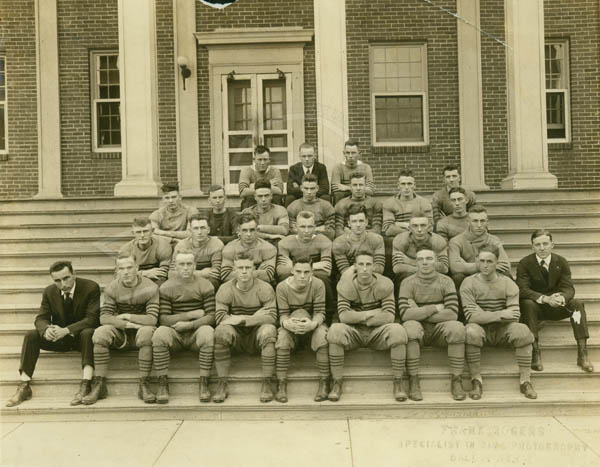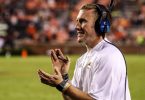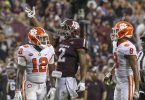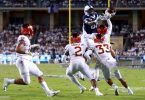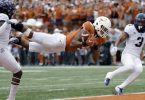The 99th playing of the football game between Dallas-Fort Worth rivals SMU and TCU will unfold Saturday on the grass at Amon G. Carter Stadium.
Except for the daytime kickoff at 2:30 p.m., little of what happens in this battle for the Iron Skillet will resemble what happened in that first game between the two in 1915, the first game in SMU’s history.
The game itself was ugly, marred by a number of turnovers committed by SMU’s roster of all freshmen. The Horned Frogs, those “purple-and-white clad warriors,” did the school proud, walking away victorious 43-0. There was no exchange or presentation of an Iron Skillet (that came later), and no one said anything about Craig James and ladies of the night.
Just how inexperienced were those Mustangs?
The next week in the school’s first victory and home opener, a 13-2 triumph over Hendrix of Conway, Ark., SMU won despite a game soiled by penalties. A report in the next day’s Dallas Morning News explained the issue.
“The Methodists were not intentionally violating the rules. They did not know what latitude in the use of their arms they were allowed.”
The observers only thought that first season post-Death Penalty was bad football.
The best story that day of Oct. 9 were the guys coaching on each sideline.
SMU’s Ray Morrison, pictured below, was in his first season, of course, but so was TCU’s Ewing Freeland. Both men were teammates and standouts on Vanderbilt’s football teams in the early 19-teens. Freeland was an interesting guy, one of the best-known athletes of his era in the South.

At Vanderbilt, he won 13 letters in football, baseball, basketball and track.
After graduating, he moved back to his native Texas to coach at Daniel Baker College, a Presbyterian school in Brownwood, the same school that serves as a basis for the historical novel penned by PressBox DFW’s Marjorie Lewis. Its motto was “Veritas et Humanitas” or “Truth and Humanity.”
The Frogs had an interest in Freeland as coach because of who he was, but they also got an up close and personal look at the Daniel Bakers in a 33-0 loss in 1914. That same year, Daniel Baker, its mascot was a goat named Hillbilly, was ranked the third best in the state. On the whole, though, it was written of Freeland at the time, that at Daniel Baker he was generally “handicapped by a lack of material.”
Freeland, who was also a professor of Greek, lasted only one season at TCU, going 4-5. The best news that season were the plans disclosed by the family of a former football player, who had died a year after graduating TCU, to raise $10,000 for a new football field.
The sisters of Noah Cushman Perkins said they would personally lead the campaign to build Perkins Athletic Field.
As for Freeland, he resigned the next summer, but why seems to have been lost to posterity. He was replaced by assistant Milton Daniel.
Freeland, pictured below, reappeared at SMU seven years later, taking on the title of co-coach with his friend Morrison. Freeland worked there for two years, the school allowing him out of a six-year contract in 1925 so he could become the first football coach at Texas Tech. Freeland is widely credited with designing the then-Matadors’ Double T icon.

When the civic leaders announced plans for an SMU football team to begin play in 1915, they added that the team would be playing under “one of the most famous coaches in the United States.” It probably wasn’t Morrison they had in mind. Who it was, who knows.
The football thing was coincidentally more about civics than college athletics. As this era of SMU football tries to convert the city of Dallas into SMU football fanatics, that’s exactly what this consortium of leaders was trying to do in 1915.
History doesn’t repeat, but it rhymes, as someone, perhaps Twain, said.
According to a Morning News account at the time: “Perhaps it would be nearer correct and much more patriotic to say that Dallas, rather than SMU, will have such an association, for the ambition of the men who attended yesterday’s luncheon was to acquire for Dallas the place in sports to which she is entitled.”
SMU would be used as a vehicle to do that.
“The view was expressed at the meeting that Dallas has a population which is intensely interested in sports and it has an unusually large number of young citizens who are anxious for their love of sport to be expressed in the support of a football team which can be claimed as their own.”
There were problems.
Many at SMU held firm to the widely held belief that football was dangerous, and, indeed, it was. Football players, in fact, were dying as a result of injuries made all the more common considering the brutality of the philosophy of play and with little protective equipment.
In 1905, 19 players were killed and 137 were seriously injured. A cartoon in the Cincinnati Commercial Tribune depicted the Grim Reaper on a goal post watching over below the mass of broken humanity.
The controversy required President Theodore Roosevelt to get involved to save the game, but he insisted that in order to do so required reform.
In light of today’s concern about head injuries in football, that rhyming scheme of history is again heard.
One of those adamantly opposed to football at SMU was the Rev. George Owens, more powerful because of the money he was able to wield than his status as an influential Methodist minister. He was called “Father of Methodists” and “church builder in Texas.”
Some in Dallas tried to publicly shame him after he pledged $5,000 to SMU only to renege, a charge levied by Henry Lindsley and endorsed by others.
At a public appearance in Dallas, the Rev. Owens had a ready explanation.
“I have firm conviction on the brutality of football. I resigned as a trustee of Polytechnic College in Fort Worth [now Texas Wesleyan University] and refused to contribute any further money, time or energy to that school because they would not discontinue in their physical culture department the playing and encouraging of semi-professional football and all of this was done after I donated to that institution a dining hall for girls and had personally educated several poor boys in that institution.”
Yes, it was true he asked for his $5,000 back, but rather than keep it, he redirected the funds to build Tyler Street Methodist Church in Oak Cliff.
Much to the consternation of Rev. Owens, SMU got its football team, and it has been both a blessing and curse over these 100-plus seasons, bringing both glory and, as Rev. Owens feared but for different reasons, shame to the university.
(Photo: 1922 SMU football team, SMU Athletics)

